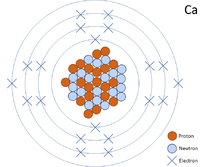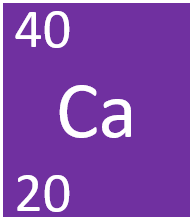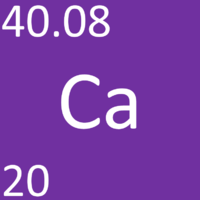Difference between revisions of "Calcium"
| (10 intermediate revisions by the same user not shown) | |||
| Line 3: | Line 3: | ||
[[Calcium]] is a [[metal]] found in our [[bone]]s. | [[Calcium]] is a [[metal]] found in our [[bone]]s. | ||
==Key Stage 3== | ==Key Stage 3== | ||
| + | [[File:CalciumSymbol1.png|right|300px|thumb|The [[Chemical Symbol|chemical symbol]] for [[Calcium]].]] | ||
| + | [[File:Ca-40_WK.PNG|right|200px|thumb|A 2 dimensional representation of a [[Calcium]] [[atom]] with 20 [[proton]]s and 20 [[neutron]]s in the [[Atomic Nucleus|nucleus]] and 20 [[electron]]s orbiting the [[Atomic Nucleus|nucleus]].]] | ||
===Meaning=== | ===Meaning=== | ||
| − | |||
[[Calcium]] is a [[Group 2]] [[element]], on the [[Periodic Table]], with an [[Atomic Number|atomic number]] of 20. | [[Calcium]] is a [[Group 2]] [[element]], on the [[Periodic Table]], with an [[Atomic Number|atomic number]] of 20. | ||
===About Calcium=== | ===About Calcium=== | ||
| − | : [[Calcium]] has the [[Chemical | + | ====Molecular Structure==== |
| + | : [[Calcium]] has the [[Chemical Symbol|chemical Symbol]] [[Calcium|Ca]]. | ||
| + | : [[Calcium]] [[atom]]s join together in large numbers to form a giant [[metal]] [[molecule]]. | ||
| + | ====Atomic Structure==== | ||
: [[Calcium]] as 20 [[proton]]s and 20 [[neutron]]s in its [[Atomic Nucleus|nucleus]] giving it an [[Atomic Number]] of 20 and an [[Relative Atomic Mass|atomic mass]] of 40. | : [[Calcium]] as 20 [[proton]]s and 20 [[neutron]]s in its [[Atomic Nucleus|nucleus]] giving it an [[Atomic Number]] of 20 and an [[Relative Atomic Mass|atomic mass]] of 40. | ||
| − | : [[Calcium]] is | + | : An [[atom]] of [[Calcium]] has only 2 [[electron]]s in its [[Outer Shell|outer shell]]. |
| + | ====Properties==== | ||
| + | : [[Calcium]] is a more [[Reactivity|reactive]] [[Alkali Earth Metal|alkali earth metal]] than [[Magnesium]] but less [[Reactivity|reactive]] than [[Strontium]]. | ||
: [[Calcium]] is more [[Reactivity|reactive]] than [[Carbon]] on the [[Reactivity Series|reactivity series]] so it must be [[Extraction of Metals|extracted]] from its [[ore]] using [[electrolysis]]. | : [[Calcium]] is more [[Reactivity|reactive]] than [[Carbon]] on the [[Reactivity Series|reactivity series]] so it must be [[Extraction of Metals|extracted]] from its [[ore]] using [[electrolysis]]. | ||
| − | : [[Calcium]] [[Chemical Reaction|reacts]] strongly with [[ | + | : [[Calcium]] [[Chemical Reaction|reacts]] strongly with [[water]] to produce [[Hydrogen]] [[gas]] and [[Calcium Hydroxide]] and strongly with [[acid]] to produce [[Calcium]] [[salt]]s. |
: [[Calcium]] is a [[solid]] at [[STP|room temperature]]. | : [[Calcium]] is a [[solid]] at [[STP|room temperature]]. | ||
| − | + | ||
| − | |||
==Key Stage 4== | ==Key Stage 4== | ||
| + | [[File:CaKS4.PNG|right|200px|thumb|The [[Chemical Symbol|chemical symbol]] for [[Calcium]].]] | ||
| + | [[File:Ca-40_WK.PNG|right|200px|thumb|A 2 dimensional representation of the [[Bohr Model]] of a [[Calcium]]-40 [[isotope]] with 20 [[proton]]s and 20 [[neutron]]s in the [[Atomic Nucleus|nucleus]] and 2 [[electron]]s in the first [[Electron Orbital|shell]], 8 in the second, 8 in the third and 2 in the [[Outer Shell|outer shell]].]] | ||
===Meaning=== | ===Meaning=== | ||
[[Calcium]] is a [[Group 2]] [[element]], on the [[Periodic Table]], with 20 [[proton]]s in the [[Atomic Nucleus|nucleus]]. | [[Calcium]] is a [[Group 2]] [[element]], on the [[Periodic Table]], with 20 [[proton]]s in the [[Atomic Nucleus|nucleus]]. | ||
===About Calcium=== | ===About Calcium=== | ||
| − | : [[Calcium]] has the [[Chemical | + | ====Molecular Structure==== |
| + | : [[Calcium]] has the [[Chemical Symbol|chemical symbol]] [[Calcium|Ca]]. | ||
| + | : [[Calcium]] [[atom]]s join together in a [[Giant Metallic Structure|giant metallic structure]]. | ||
| + | ====Atomic Structure==== | ||
: The most [[Stable Isotope|stable isotope]] of [[Calcium]] has 20 [[neutron]]s in its [[Atomic Nucleus|nucleus]] giving it an [[Relative Atomic Mass|atomic mass]] of 40. | : The most [[Stable Isotope|stable isotope]] of [[Calcium]] has 20 [[neutron]]s in its [[Atomic Nucleus|nucleus]] giving it an [[Relative Atomic Mass|atomic mass]] of 40. | ||
| + | : An [[atom]] of [[Calcium]] has only 2 [[electron]]s in its [[Outer Shell|outer shell]]. | ||
| + | : [[Calcium]] [[ion]]s have lost two [[electron]]s to become [[Positive Charge|positively charged]]. | ||
| + | ====Properties==== | ||
| + | : [[Calcium]] is a more [[Reactivity|reactive]] [[Alkali Earth Metal|alkali earth metal]] than [[Magnesium]] but less [[Reactivity|reactive]] than [[Strontium]]. | ||
: [[Calcium]] is more [[Reactivity|reactive]] than [[Carbon]] on the [[Reactivity Series|reactivity series]] so it must be [[Extraction of Metals|extracted]] from its [[ore]] using [[electrolysis]]. | : [[Calcium]] is more [[Reactivity|reactive]] than [[Carbon]] on the [[Reactivity Series|reactivity series]] so it must be [[Extraction of Metals|extracted]] from its [[ore]] using [[electrolysis]]. | ||
| − | + | : [[Calcium]] [[Chemical Reaction|reacts]] strongly with [[water]] to produce [[Hydrogen]] [[gas]] and [[Calcium Hydroxide]] and strongly with [[acid]] to produce [[Calcium]] [[salt]]s. | |
| − | : [[Calcium]] [[Chemical Reaction|reacts]] strongly with [[ | + | : [[Calcium]] is a [[solid]] at [[STP|standard temperature and pressure]]. |
| − | : [[ | ||
| − | |||
| − | |||
Latest revision as of 14:03, 19 February 2021
Contents
Key Stage 2
Meaning
Calcium is a metal found in our bones.
Key Stage 3
Meaning
Calcium is a Group 2 element, on the Periodic Table, with an atomic number of 20.
About Calcium
Molecular Structure
- Calcium has the chemical Symbol Ca.
- Calcium atoms join together in large numbers to form a giant metal molecule.
Atomic Structure
- Calcium as 20 protons and 20 neutrons in its nucleus giving it an Atomic Number of 20 and an atomic mass of 40.
- An atom of Calcium has only 2 electrons in its outer shell.
Properties
- Calcium is a more reactive alkali earth metal than Magnesium but less reactive than Strontium.
- Calcium is more reactive than Carbon on the reactivity series so it must be extracted from its ore using electrolysis.
- Calcium reacts strongly with water to produce Hydrogen gas and Calcium Hydroxide and strongly with acid to produce Calcium salts.
- Calcium is a solid at room temperature.
Key Stage 4

A 2 dimensional representation of the Bohr Model of a Calcium-40 isotope with 20 protons and 20 neutrons in the nucleus and 2 electrons in the first shell, 8 in the second, 8 in the third and 2 in the outer shell.
Meaning
Calcium is a Group 2 element, on the Periodic Table, with 20 protons in the nucleus.
About Calcium
Molecular Structure
- Calcium has the chemical symbol Ca.
- Calcium atoms join together in a giant metallic structure.
Atomic Structure
- The most stable isotope of Calcium has 20 neutrons in its nucleus giving it an atomic mass of 40.
- An atom of Calcium has only 2 electrons in its outer shell.
- Calcium ions have lost two electrons to become positively charged.
Properties
- Calcium is a more reactive alkali earth metal than Magnesium but less reactive than Strontium.
- Calcium is more reactive than Carbon on the reactivity series so it must be extracted from its ore using electrolysis.
- Calcium reacts strongly with water to produce Hydrogen gas and Calcium Hydroxide and strongly with acid to produce Calcium salts.
- Calcium is a solid at standard temperature and pressure.

